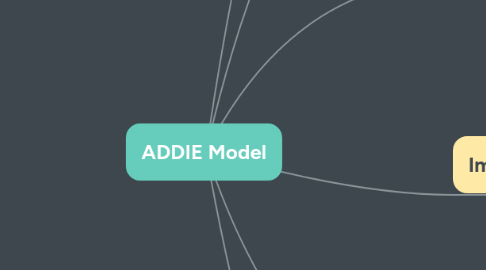
1. Analyze
1.1. Phase: Construction of training plan and desired approach style.
1.2. What is the current situation? What knowledge do the learners already possess? What do they need to know?
1.2.1. Identify instructional issue/objective.
1.2.2. Determine what learners need to accomplish.
1.3. What are we trying to accomplish? What methods are we going to use do do so? How are we going to quantify results?
1.3.1. Identify explicit learning objectives.
1.3.2. Identify desired outcomes among learners.
1.3.3. Identify basic approaches for communication and evaluation.
1.4. Who, what, where, when, how, why?
1.4.1. Identify the above, along with practical constraints (budget, materials available, timeline, etc).
2. Develop
2.1. Phase: Production of actual course materials and final testing.
2.2. How are we implementing our design as we construct content? Are we using the technologies predicted? Do we have a consistent model and organization?
2.2.1. Determine technology availability, acquire access/licenses.
2.2.2. Create content according to a consistent model, assemble text, readings, assignments.
2.2.3. Inspect initial construction to ensure learning objective are theoretically achieved.
2.3. Is the content presented properly and easily navigable between instruction and evaluation items?
2.3.1. Review construction as it progresses for iterative improvement.
2.3.2. Ensure that learning objectives and macro objectives are serviced by content organization and placement.
2.4. Can the learner progress in the way that that was designed?
2.4.1. Conduct full testing with simulated user/instructor accounts.
2.4.2. Solicit feedback from testers and continue improvement.
3. Design
3.1. Phase: Storyboards, Pre-construction testing and revision.
3.2. What is our general strategy? What are our learning objectives? What technologies are we going to be using?
3.2.1. Determine macro-stage objectives for the course and content.
3.2.2. Create lesson plans and modular/sectional goals and progression paths.
3.2.3. Identify external tools/technologies that will be used.
3.2.4. Conduct inventory and determine budgetary allowances.
3.3. How are we prototyping the course and content? How are we using that to communicate and collaborate with all designers?
3.3.1. Create initial mockups of content (storyboards, etc).
3.3.2. Prototype initial progression of learners through desired content
3.4. How are we conducting initial testing?
3.4.1. Determine methods for the above
4. Implement
4.1. Phase: Delivery of content and initial monitoring/small fixes.
4.2. How are we sharing our content with the learner? Which LMS are we using and how does it interact differently than others?
4.2.1. Ensure the content is implemented properly in the LMS of choice.
4.2.2. Check links to readings, content, assignments, etc.
4.3. Are instructors and facilitators/assistants properly trained and provided with necessary supporting materials?
4.3.1. Conduct training sessions.
4.3.2. Develop and deliver supporting and guide materials.
4.4. Are learners properly assigned to their courses, sections, and groups?
4.4.1. Ensure course commencement and student addition proceeds properly.
4.5. Is the course proceeding well? Are there major issues developing? Are/Were we able to properly pilot the content first?
4.5.1. Monitor the course as it progresses for minor issues, inconsistencies, or mistakes and fix them as needed.
5. Evaluate
5.1. Phase: Evaluation of success and identification of avenues for iterative improvement.
5.2. Are we consistently and constantly evaluating our content and progress?
5.2.1. Evaluate progress at every stage of the process and consistently identify avenues for improvement.
5.2.2. Develop a framework for feedback collection (through LMS, external, etc)
5.3. Are we collecting feedback on the course and content at every step of the model?
5.3.1. Implement data collection as determined, from developers, facilitators, instructors, and students.
5.3.2. Collect feedback both on content and on course structure and objectives themselves.
5.4. Are we meeting our course goals and objectives, and are learners responding positively to our implementation?
5.4.1. Keep watch on the success of the course as it fits learning objectives.
5.4.2. Analyze student responses to content, submitted assignments, discussions, and the like for evidence of success/issue.
5.5. How can we improve all aspects of the course as applied to this model?
5.5.1. Interpret collected data through comparison to storyboards and testing.
5.5.2. Interview facilitators and instructors.
5.5.3. Identify explicit items for improvement and apply them to their respective stages as the cycle continues.
